Landforms of Wind Erosion in Desert
by Devender
0 2544
There are 7 types of landforms formed from wind erosion in deserts that are:
- Rock pedestals/Mushroom rocks
- Zeugen
- Yardangs
- Mesas & Buttes
- Isenberg (Island Mountain)
- Ventifacts & Dreikanter
- Deflation Hollows
- These rock pillars get further eroded near their bases where friction is greatest
- This process of undercutting produces rocks of mushroom shape called mushroom rocks
- Mechanical weathering initiates their formation by opening up joints of the surface rocks
- Wind abrasion further eats into the underlying softer layer so that deep furrows are developed
- The hard rocks then stand above the furrows as ridges or Zeugen
- Zeugen may stand 10 to 100 feet above the sunken furrows
- The continuous abrasion by winds gradually lowers the Zeugen & widens the furrow
- The rocks are aligned in the direction of prevailing winds
- Composed of granite or gneiss
- These are probably relics of an original plateau that has been almost entirely eroded away
- If the wind direction changes another facet is developed
- Among the ventifacts, those with the three wind faceted surfaces are known as Dreikanter
Landforms of Wind Erosion in Desert
1 Rock pedestals/Mushroom rocks
These are formed by the sandblasting effect of winds against any projecting rock masses. It cuts down the softer layer leading to the formation of irregular edges on alternate bands of softer & harder rocks. The grooves & hollows cut in the rock surfaces, carve them into grotesque-looking pillars known as rock pedestals.
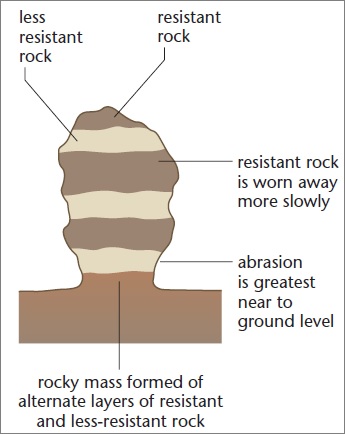
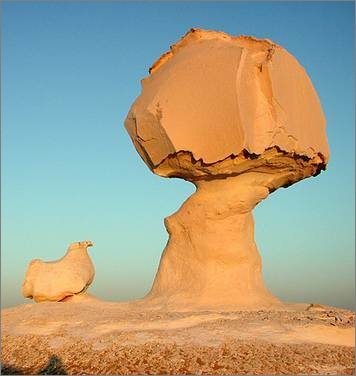
2 Zeugen
The tabular masses that have a layer of soft rocks lying beneath a surface layer of more resistant rocks are known as Zeugen. The erosional effect of the wind is different on soft & resistant rock surfaces and it carves them into weird-looking ridge & furrow landscapes.
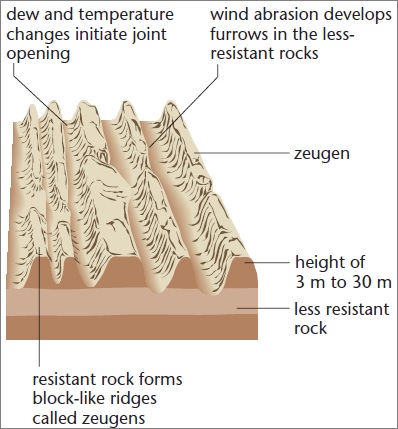
3 Yardangs
These look similar to the Zeugen but instead of lying in horizontal strata like Zeugen, the hard & soft rocks of Yardangs lie in vertical bands. Winds abrasion excavates the bands of softer rocks into long, narrow corridors, separating the steep-sided overhanding ridges of hard rocks called Yardangs.
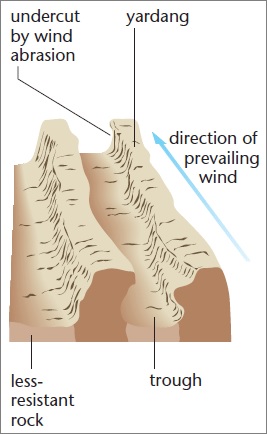
4 Mesas & Buttes
Mesa is a flat, table-like landmass with a very resistant horizontal top layer & very steep sides that may be formed in the canyon region. The hard stratum on the surface resist denudation by both wind & water thus protects the underlying layer of rocks from being eroded.
The continuous denudation through ages may reduce Mesas in the area so that they become isolated flat-topped hills called Buttes, many of which are separated by deep gorges & canyons.
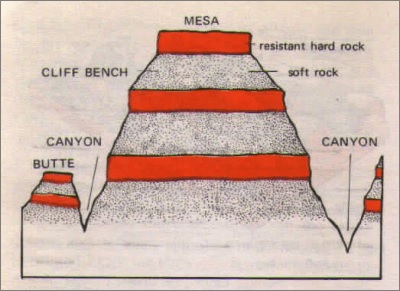
5 Isenberg (Island Mountain)
These are isolated residual hills rising abruptly from the ground level and characterized by very steep slopes & rather rounded tops.
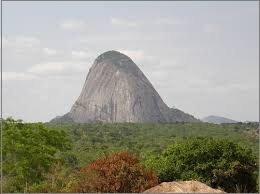
6 Ventifacts & Dreikanter
Ventifacts are generally pebbled faceted & edged by sandblasting. The rock fragments weathered from mountains are shaped & polished thoroughly by wind abrasion and get smoothened on the windward side.
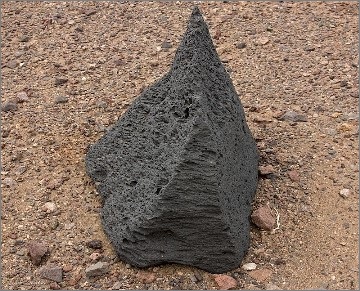
7 Deflation Hollows
Wind lowers the ground by blowing away the unconsolidated material forming small depressions. Identically, minor faulting can also initiate depressions which along with the eddying action of oncoming winds will wear off the weaker rocks until the water table is reached.
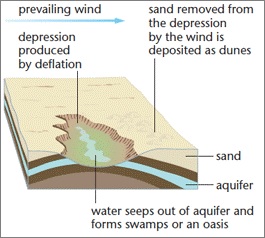
Then, water seeps out forming oasis or swamps in deflation hollows or depressions. Large areas in the western USA were stripped of their natural vegetation a were completely deflated by strong winds. These winds moved materials as dust storms & created what is known as the Great dust bowl.

Share:







Comments
Waiting for your comments